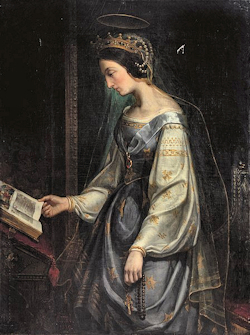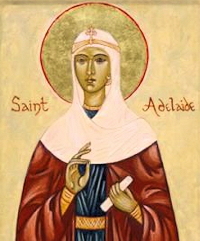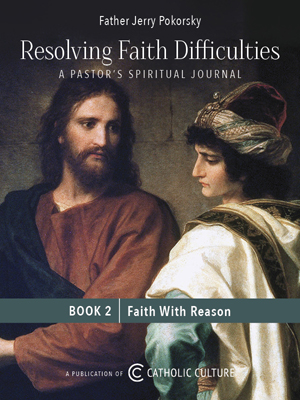Advent: December 16th
Tuesday of the Third Week of Advent
Other Commemorations: St. Adelaide, Empress and Widow (RM)
» Enjoy our Liturgical Seasons series of e-books!
In the General Roman Calendar, this date is a weekday in Advent. No feast of a saint is celebrated. The readings lead us to prepare for Christmas when Christ's first coming to us is remembered and to direct our mind and heart to await Christ's Second Coming at the end of time. Advent is thus a period for devout and joyful expectation.
Before the reform of the Roman Calendar in 1969, this was the memorial of St. Eusebius, bishop and martyr. His feast is now celebrated on August 2.
![]()
Salvation History Meditation — John the Baptist
During Advent we review our salvation history. Today we reflect on St. John the Baptist. This is the one of whom the prophet Isaiah spoke when he said, "The voice of one crying out in the wilderness: "Prepare the way of the Lord, make his paths straight." The shell with three water drops is a symbol of baptism generally, and especially of the baptism of Christ. The three droplets remind us of the Trinity — Father, Son and Holy Spirit — into which Christians are baptized. The shell alone may also be used as a symbol for pilgrimage, and may be used as an emblem for saints known for their travels or whose shrines have become destinations for pilgrims.
Symbols: Shell
Suggested Readings: Jeremias 1:5; 9-10; Matthew 3:1-12.
St. Adelaide
 St. Adelaide was a truly remarkable woman. She was the daughter of the king of Burgundy, and was married to Lothair of Italy, the son of the ruler of Provence as a means of ending a feud. When her husband was murdered by a rival prince, she was shut up in captivity by Berengarius of Ivrea, until rescued by the emperor Otto the Great, who married her. Otto I became Holy Roman Emperor and Adelaide, his Empress. She ruled with her husband until his death, at which time she was badly treated by her son Otto II, and later her jealous daughter-in-law who was co-regent with Adelaide for her grandson Otto III. The daughter-in-law Theophano had her banished from the court twice, yet Adelaide remained steadfast and faithful, known for her liberality in giving and her piety; and eventually she was restored to court as the regent for her grandson Otto III. She was active in the reforms of the great abbey at Cluny, and reposed in 999. She took as her counsellors St. Adalbert of Magdeburg and SS. Majors and Odilo of Cluny. After Otto was old enough to reign on his own, Adelaide retired to the convent of Selta (Selz Abbey) near Cologne, a house she had built. Though she never became a nun, she spent the rest of her days there in prayer. The Abbey is no longer in existence. Some of her relics are enshrined in Hanover.
St. Adelaide was a truly remarkable woman. She was the daughter of the king of Burgundy, and was married to Lothair of Italy, the son of the ruler of Provence as a means of ending a feud. When her husband was murdered by a rival prince, she was shut up in captivity by Berengarius of Ivrea, until rescued by the emperor Otto the Great, who married her. Otto I became Holy Roman Emperor and Adelaide, his Empress. She ruled with her husband until his death, at which time she was badly treated by her son Otto II, and later her jealous daughter-in-law who was co-regent with Adelaide for her grandson Otto III. The daughter-in-law Theophano had her banished from the court twice, yet Adelaide remained steadfast and faithful, known for her liberality in giving and her piety; and eventually she was restored to court as the regent for her grandson Otto III. She was active in the reforms of the great abbey at Cluny, and reposed in 999. She took as her counsellors St. Adalbert of Magdeburg and SS. Majors and Odilo of Cluny. After Otto was old enough to reign on his own, Adelaide retired to the convent of Selta (Selz Abbey) near Cologne, a house she had built. Though she never became a nun, she spent the rest of her days there in prayer. The Abbey is no longer in existence. Some of her relics are enshrined in Hanover.
Despite her exalted status, she was a wife and mother, and lived both hard times and good, always faithful to her Lord, and always ready to give generously to those in need. She never took revenge on her political enemies once she gained the regency and it was said that her court was much like a monastery itself in its piety. She is a reminder to me that regardless of how much or how little I may have, my work remains the same.
—Excerpted from Panagia Icons and A Dictionary of Saints by Attwater
Patronage: abuse victims; against in-law problems; brides; empresses; exiles; parenthood; parents of large families; people in exile; princesses; prisoners; second marriages; step-parents; victims of abuse; widows; Cluny, France
Symbols and Representation: empress dispensing alms and food to the poor, often beside a ship; escaping from prison in a boat; holding a church; veil
Highlights and Things to Do:
- Read more about St. Adelaide:






